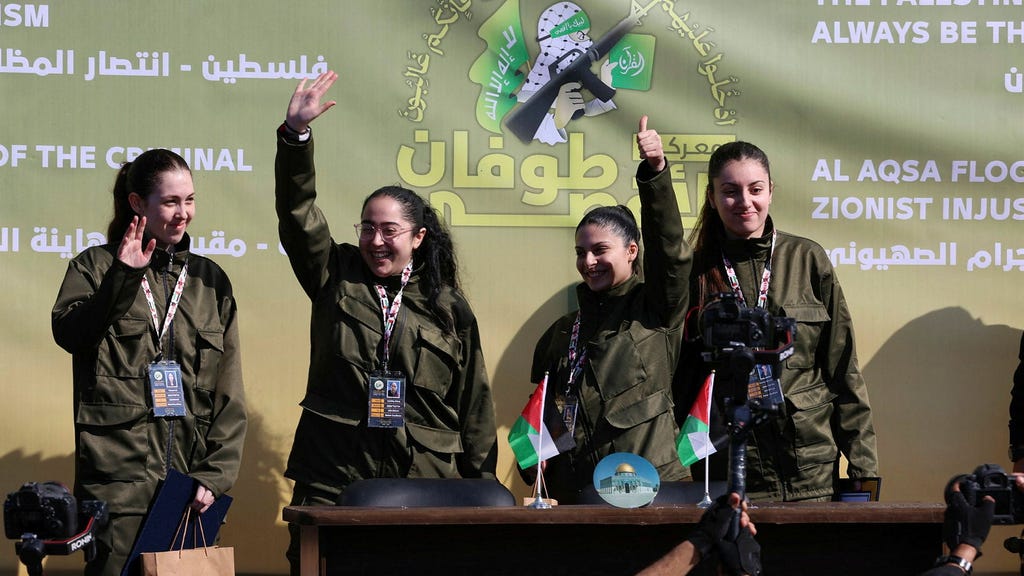The release of four Israeli soldiers held captive by Hamas unfolded dramatically in Gaza City on Saturday morning, marking a pivotal moment in the ongoing conflict. Hundreds of Palestinians, a significant number identified as Hamas and Palestinian Islamic Jihad militants, gathered at Palestine Square in anticipation of the event. The soldiers, Karina Ariev, Daniella Gilboa, Naama Levy, and Liri Albag, all in their twenties, had been held hostage since October 7th, 2023, after their capture at the Nahal Oz base on the Israeli side of the Gaza border. Their public appearance on a stage erected in the square, broadcast internationally by news outlets like CNN and Al-Jazeera, resonated with both celebration and concern.
Shortly after their brief appearance before the cheering crowds, the freed soldiers were escorted to waiting vehicles provided by the International Red Cross. Simultaneously, in Tel Aviv, thousands of Israelis watched the emotional release unfold on screens, marking a moment of palpable relief. The liberated soldiers were transported to a nearby military base and subsequently flown by helicopter to a military hospital in Israel, where anxious families awaited their return. The release came at a price: the exchange of 200 Palestinian prisoners, 70 of whom were designated to be released on the Egyptian side of Rafah, without authorization to enter either Gaza or the West Bank.
The orchestrated nature of the release, and the deliberate presence of a significant number of combatants from Hamas’ Qassam Brigades and the Palestinian Islamic Jihad’s al-Quds Brigades, sent a potent message. Analysts, such as Muhanad Seloom, Associate Professor of Critical Security Studies at the Doha Institute for Graduate Studies, interviewed by Al-Jazeera, interpreted the display of military strength as a symbolic assertion of Hamas’ continued power and control, a direct challenge to Israel’s narrative of dominance. The choice of Gaza City as the location for the handover further underscored this message. It served as a stark reminder that Hamas operates effectively within the heart of the territory, despite Israeli claims of control.
Beyond the strategic implications, the release triggered a wave of jubilation in Gaza City. For many Palestinians, this exchange held even greater significance than the initial ceasefire agreement. The release of the soldiers paved the way for Israel’s withdrawal from northern Gaza, a crucial step towards allowing displaced Palestinians to return to their homes. Starting the following morning, hundreds of thousands of Palestinians who had been forced to flee their devastated homes were expected to begin their journey back. Scenes of anticipation and some chaos were already evident at the Netzarim Corridor, as thousands queued, eager to return.
The event marked a moment of profound emotional resonance, as families separated by conflict prepared for reunification. Al-Jazeera captured the sense of elation and historical significance, emphasizing the prospect of families returning to their homes and rebuilding their lives. While the release of the soldiers offered a moment of respite, the underlying complexities of the conflict remained. The Israeli army spokesperson, Daniel Hagari, while welcoming the soldiers home, pointedly emphasized Hamas’ breach of agreement by releasing military personnel instead of the civilian hostages. The unresolved issue of the remaining 90 hostages cast a long shadow over the celebration, a stark reminder of the fragility of the peace and the ongoing human cost of the conflict.
The events of this day underscore the volatile nature of the Israeli-Palestinian conflict. The release of the Israeli soldiers, while a cause for celebration and relief for many, was intricately woven with political maneuvering, strategic messaging, and the unresolved plight of remaining hostages. The jubilation in Gaza, tempered by the devastation and displacement, highlights the deep-seated yearning for peace and the complexities that continue to fuel the conflict. The international community remained watchful, acknowledging the fragile nature of the ceasefire and the urgent need for a lasting solution that addresses the underlying issues driving the conflict.














